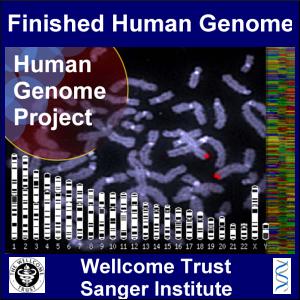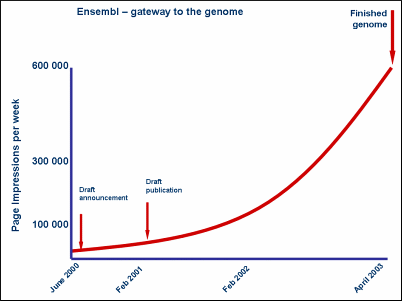The Finished Human Genome - Wellcome To The Genomic Age

The Wellcome Trust Sanger Institute, which was the only British organisation involved in the project, carried out nearly one-third of the work, making it the biggest contributor.*
Less than three years ago the international team announced the original working draft of the three billion letters that make up the code of life. However, the finished sequence, announced today, is essential for growth of research worldwide to produce further medical advances.**
Anticipating this valuable resource, the Wellcome Trust Sanger Institute has already established programmes to tackle many of our common diseases. These have already led to new medical insights, such as a mutation that causes malignant melanoma.
“Completing the human genome is a vital step on a long road but the eventual health benefits could be phenomenal.
“Just one part of this work – the sequencing of chromosome 20 – has already accelerated the search for genes involved in diabetes, leukaemia and childhood eczema.
“We shouldn’t expect immediate major breakthroughs but there is no doubt we have embarked on one of the most exciting chapters of the book of life.”
Professor Allan Bradley Director of The Wellcome Trust Sanger Institute

Human genome data has attracted a huge number of enquiries from researchers around the world, with weekly hits on the Ensembl website*** – co-run by the Wellcome Trust Sanger Institute – rising from 30,000 in June 2000, when the draft sequence was announced, to almost 600,000 today. Scientists from more than 120 countries have made use of this valuable resource.
Access to comprehensive genomic data is powering drug discovery research in academic and commercial organizations. More than 350 biomedical advances have reached clinical trial stage, although experts point out it will be many years before new drugs emanating from the genome are produced.
The sequence of the human genome will underpin biomedical research for decades: one of the demands of the research community was that the reference human sequence should be finished to the highest standards possible. The Sanger Institute is achieving an accuracy rating of 99.999%
“We have reached the limits we set on this project, achieving tremendously high standards of quality much more quickly than we hoped.
“The working draft allowed researchers to kick-start a multitude of biomedical projects. Now they have a highly polished end product which will assist them even more. It’s a bit like moving on from a first-attempt demo music tape to a classic CD.”
Dr. Jane Rogers Head of Sequencing at the Wellcome Trust Sanger Institute
The accurate genome sequence will allow researchers to identify genes involved in more complex diseases including cancer and diabetes.
“One of the great benefits to spring from the Human Genome Project is the full catalogue of genes, which gives us a clearer route to therapies. We now have a better navigating system. Using this, we have found genes that may compensate for the defect in muscular dystrophy using entirely novel methods, which could have implications for thousands of people.”
Professor Kay Davies Department of Human Anatomy and Genetics, University of Oxford
Before the sequencing project began it could take researchers months or even years to find one gene. Now the same task can be completed in hours or days.
“The completed sequence will greatly help in the mapping of disease genes from the unfinished chromosomes. Dealing with the fragmentary information provided by the draft was better than dealing with no information at all, but the finished sequence will make our lives as disease gene hunters much easier.”
Professor William Cookson Senior Clinical Fellow at the Wellcome Trust Centre for Human Genetics, Oxford
In the last ten years, The Wellcome Trust Sanger Institute has grown from 17 staff to 650 today and is a world leader, not only in sequencing DNA, but also in understanding the messages in our genes to improve human health. The achievement of a finished human genome sequence comes 50 years after James Watson and Francis Crick first elucidated the double-helical structure of DNA.
More information
* A UK success story
Of the 2.9 billion letters of DNA code that have been read, the Wellcome Trust Sanger Institute has contributed more than 0.8 billion – 30%. Originally committed to sequencing one-sixth of the human genome, The Wellcome Trust increased its investment in 1998 to allow the Institute to decode one-third of the genome, that of chromosomes 1, 6, 9, 10, 13, 20, 22 and X.
The Wellcome Trust Sanger Institute is producing less than one error in every 100,000 bases. To provide rigorous analysis of accuracy, the error rates are determined not only by reanalysis internally but also through reanalysis of data by external organizations.
Funding from the Wellcome Trust for the Sanger contribution to the sequence of the human genome has totalled £150 M.
** Some Examples
From just one chromosome sequenced at the Wellcome Trust Sanger Institute – chromosome 20 – researchers from around the world have identified new genes involved in diseases such as:
Diabetes
Francis Collins, Director, National Human Genome Research Institute, US, said, “One of our projects is to identify genes that predispose to type II diabetes. This disease affects about 1 in 20 people over 45 and its incidence appears to be increasing. Using freely available map and sequence information [we] have been able to close in on the likely gene on chromosome 20 that is altered in type II diabetes. “The Wellcome Trust Sanger Institute is to be congratulated for this contribution to humanity.”
Leukaemias
Professor Green, Addenbrooke’s Hospital, Cambridge, UK, said: “Medical research into cancer, a set of diseases that always involves alteration in the behaviour of genes, relies on decoding the DNA sequence to understand the changes in DNA code … We hope that we can continue in our efforts so that in the future we can bring the real result from genomics and clinical science – benefit to the patient.”
Childhood eczema
Professor Cookson, Senior Clinical Fellow at the Wellcome Trust Centre for Human Genetics, Oxford, said: “Finding the genes underlying common complex diseases is essential, but extraordinarily difficult. … for the first time, we have the ability to look at all genes that may be involved in disease at once. This may take four years off the usual six years for the gene discovery process, and is a huge advance.”
https://www.sanger.ac.uk/news_item/2001-12-20-dermatitis-diabetes-dementia/
Crohn’s disease
The gene involved in Crohn’s disease has been identified – it is involved in the normal immune response and its identification means we can pick apart the events that lead to this relatively common disease.
http://www.ncbi.nih.gov/Coffeebreak/CB21_Crohns/page.html
Malignant melanoma
Already a gene has been identified at The Wellcome Trust Sanger Institute that is involved in most cases of malignant melanoma, and the search for treatments – rationally chosen – is underway. Although the gene, called BRAF, had been known for about ten years, no one suspected it was involved in this disease.
https://www.sanger.ac.uk/about/press/2002/020609.html
Glaucoma
Novel genes have been found – such as the GLCA1 gene is involved in many cases of glaucoma. The gene discovery means an early test can be developed to make sure those at risk are aware.
http://www.ncbi.nlm.nih.gov/disease/Glaucoma.html
***Global genome
Ensembl (http://www.ensembl.org/) is a ‘genome browser’ – it acts as a zoom lens to take a researcher from an overall view to the finest detail currently available. Moreover, it includes analysis of the reference human genome, predicts genes that are new to biology, includes all publicly available DNA variation information, analyses the genomes of mouse and other organisms and links all this information to known disease states.
Weekly traffic at Ensembl has grown from 30,000-40,000 page impressions in June 2000 (the announcement of the draft sequence) to about 100,000 in February 2001 (the publication in Nature of the draft sequence), to almost 600,000 today.
UK and US institutions are the heaviest users, but the top 50 also includes nations such as India, Brazil, Mexico and Slovenia as well as all major developed countries.
Contributing Centres
The list of institutions that form the Human Genome Sequencing Consortium include can be found here.
Additional Quotes
Sir John Sulston, Nobel Laureate and founding Director of The Wellcome Trust Sanger Institute, said: “This year we are celebrating the completion of the human genome sequence. Collectively we shall have produced a sequence that is as accurate and complete as possible in the present state of the art. It will be open for continuous improvement over the years to come, and of course open for all to use for any purpose, without restraint or fee. Let us continue to work together to ensure that the enormous benefits from this new knowledge flow to all and not just to the few.”
Philippe Sanseau, WW Director Target Bioinformatics at GlaxoSmithKline, said: “For GSK, ENSEMBL has nicely provided the key element to develop a genome portal accessible by our scientists. In addition to public domain information we have integrated GSK proprietary information to develop GSK-ENSEMBL. The fact that “open source code” was the philosophy of the ENSEMBL team has been very useful not only for GSK-ENSEMBL but also to integrate ENSEMBL with other components of our bioinformatics tools and applications repertoire. Currently, for GSK, ENSEMBL is our key interface to deliver genome sequence information.”
Mathew Woodwark, Associate Director, Bioinformatics at AstraZeneca, said: “At AstraZeneca, EnsEMBL’s high quality genome annotation is an integral part of our Bioinformatics platform, used by scientists across the world as part of their drug discovery toolkit.”
Nicolas Chalwatzis, Head of Bioinformatics Germany, Aventis Pharma, said: “At Aventis, the ENSEMBL platform has rapidly become a key component of our Bioinformatics strategy. Representing as it does the cumulative knowledge of the global scientific community, it forms an excellent framework onto which we can build our combined public and proprietary compendium of sequence-based biological data. ENSEMBL also provides the tools and interface that enable us to utilize this information and build knowledge within global Aventis research.”
Tim Hubbard, Head of Human Genome Analysis at the Wellcome Trust Sanger Institute, said: “The more scientists can access and investigate a piece of data, the more informative it becomes. Ensembl is one of a network of key public domain sites providing free access to biological information. This is helping accelerate research by connecting researchers through the internet regardless of the country in which they work.


